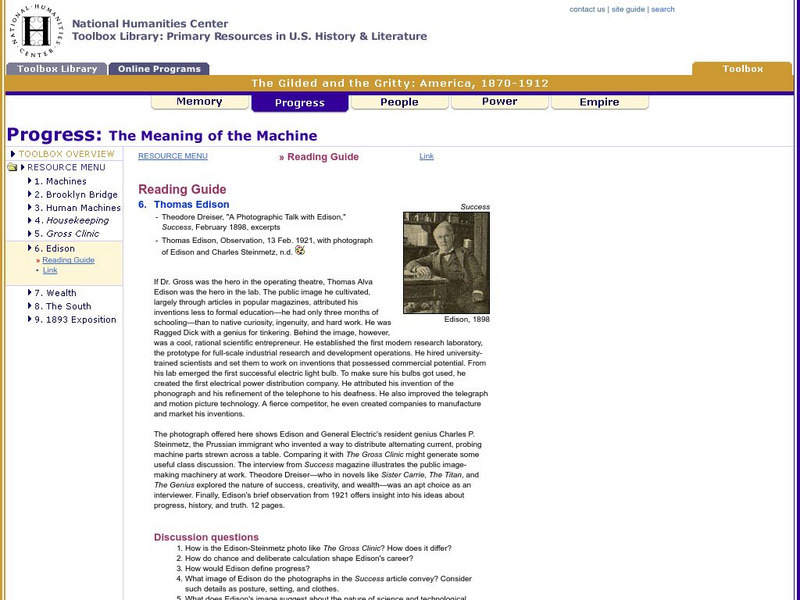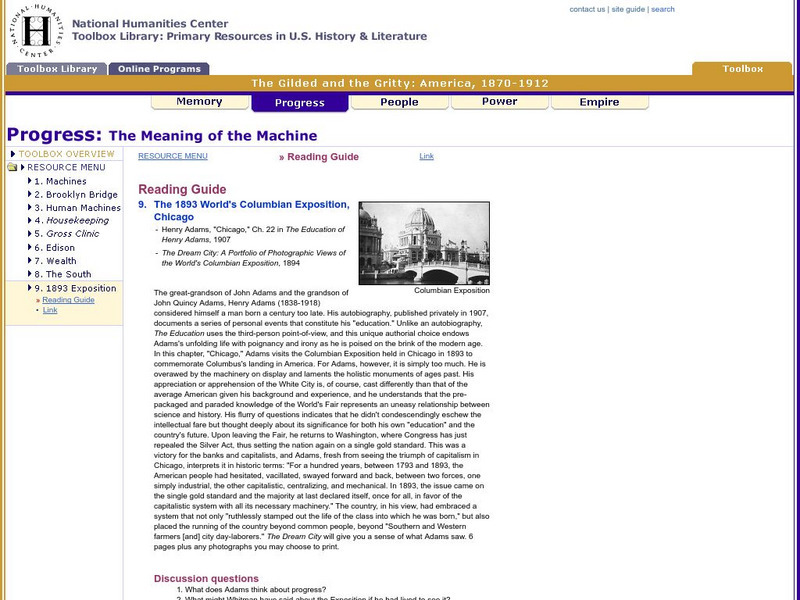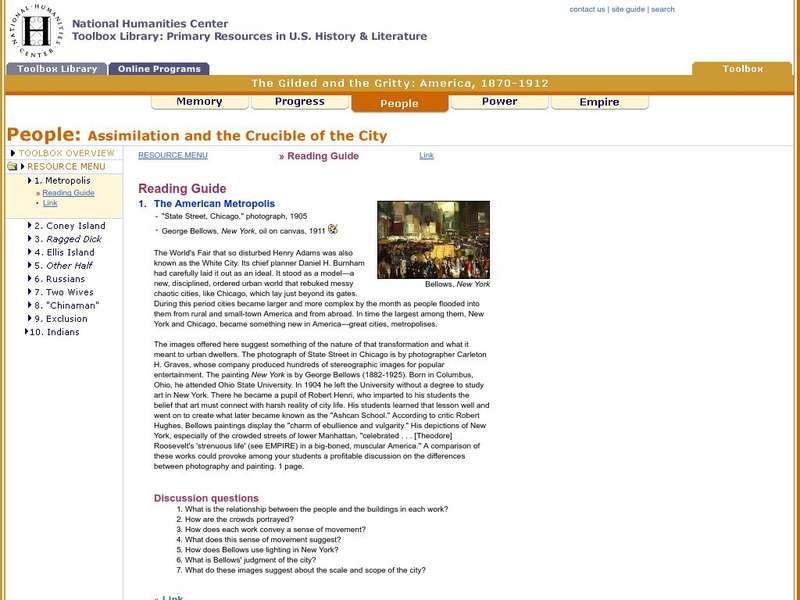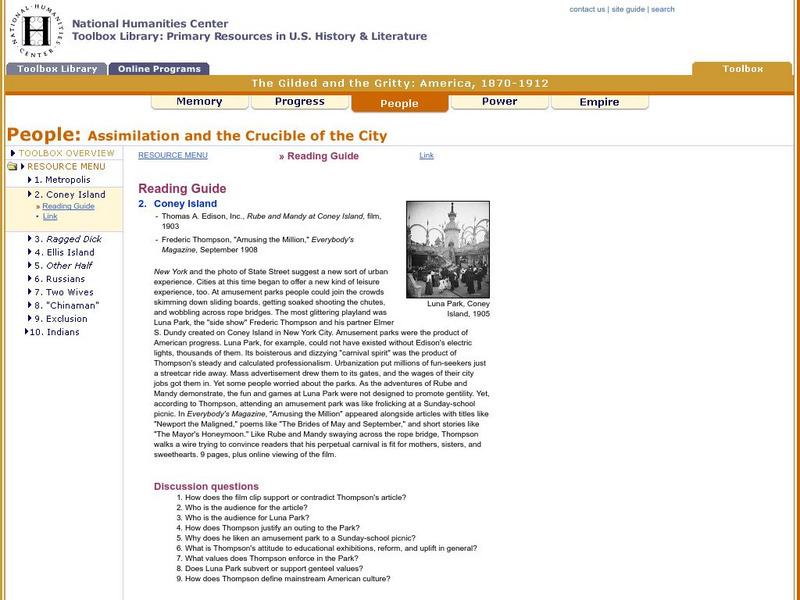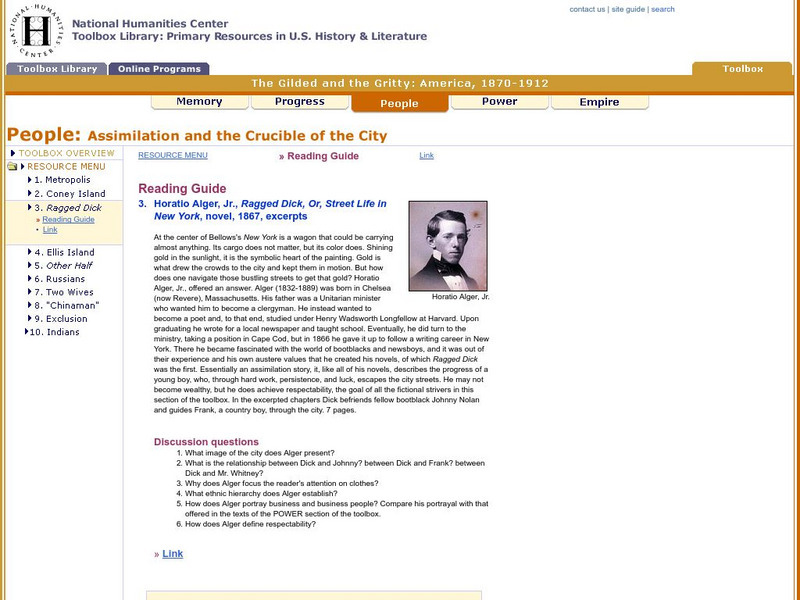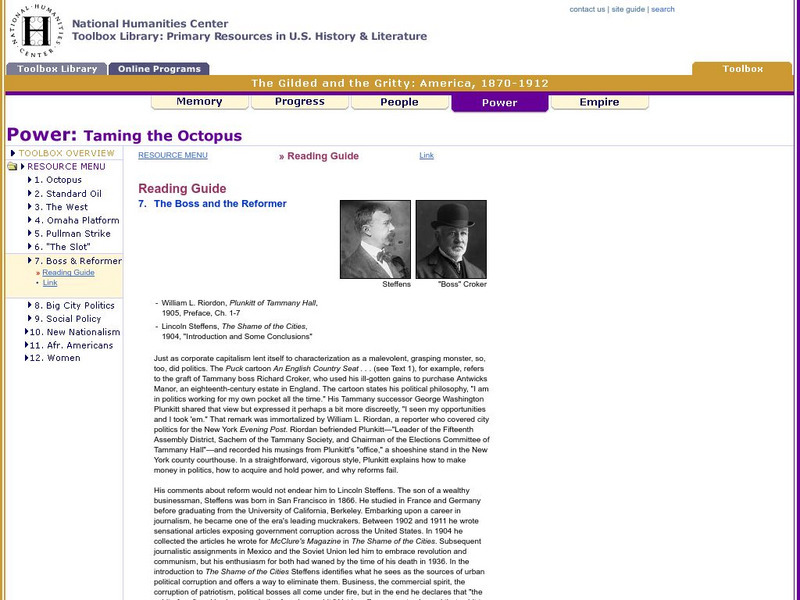National Humanities Center
National Humanities Center: Toolbox Library: Progress: The Meaning of the Machine: Thomas Edison
A photograph of Edison and an interview of Edison by Theodore Dreiser that displays the inventor's convictions about progress in America.
National Humanities Center
National Humanities Center: Toolbox Library: Wealth, the Gilded and the Gritty: America, 1870 1912
An excerpt from Andrew Carnegie's autobiography that describes his attitude toward wealth and an excerpt from the novel The Gilded Age by Mark Twain and Charles Dudley Warner that suggests the giddy, unreality of an America caught up in...
National Humanities Center
National Humanities Center: Toolbox Library: Progress: The Meaning of the Machine: Southern Stasis
A survey of the lagging Southern economy of the late-nineteenth century and two speeches, one by a black Southerner and one by a white Southerner, making the case for Northern investment in the region.
National Humanities Center
National Humanities Center: Toolbox Library: The Meaning of the Machine: The 1893 World's Columbian Exposition
Two views of late-nineteenth-century American progress: Henry Adams criticizes it in his autobiography, and the Columbian Exposition of 1893 praises it.
National Humanities Center
National Humanities Center: Toolbox Library: People: Assimilation and the Crucible of the City: The American Metropolis
A photograph of State Street in Chicago and George Bellows' painting of Lower Manhattan, both depicting the vigorous, gritty, energetic urban life in the early-twentieth century.
National Humanities Center
National Humanities Center: Toolbox Library: Coney Island, the Gilded and the Gritty: America, 1870 1912
A Thomas Edison film and an essay about the amusement park experience, a new leisure pastime made possible by urbanization and industrialization.
National Humanities Center
National Humanities Center: Toolbox Library: People: Assimilation and the Crucible of the City: Street Life in New York
Excerpt from Horatio Alger's well-known novel, "Ragged Dick, Or, Street Life in New York," that describes the values and attitudes needed to make it in the capitalistic, urban America of the late-nineteenth century.
National Humanities Center
National Humanities Center: Toolbox Library: Ellis Island, the Gilded and the Gritty: America, 1870 1912
This lesson examines seven Lewis Hine photographs of recently-arrived immigrants at Ellis Island.
National Humanities Center
National Humanities Center: Toolbox Library: People: Assimilation and the Crucible of the City: How Other Half Lives
Photographs and an excerpt from Jacob Riis's famous tour of the distressing conditions of the tenements in New York City. Includes questions for discussion.
National Humanities Center
National Humanities Center: Toolbox Library: Assimilation and the Crucible of the City: Reading Guide to Yerzierska
Two short stories from Polish immigrant, Anzia Yerzierska, about the challenges of Americanization that immigrants faced in the early-twentieth century. Includes questions for discussion.
National Humanities Center
National Humanities Center: Toolbox Library: Assimilation and the Crucible of the City: Reading Guide: Two Stories
An excerpt from Abraham Cahan's novel, "Yekl: A Tale of the New York Ghetto," and Charles Chesnutt's short story, "The Wife of His Youth," that describe challenges of assimilation into American culture for both European immigrants and...
National Humanities Center
National Humanities Center: Toolbox Library: Lee Chew, "The Biography of a Chinaman"
A story of the rise, the challenges, and the alienation experienced by one Chinese immigrant in America. Questions for discussion included.
National Humanities Center
National Humanities Center: Toolbox Library: People: Assimilation and the Crucible of the City: Exclusion
This lesson examines government reports that urged restrictions on immigration to America at the turn of the nineteenth century.
National Humanities Center
National Humanities Center: Toolbox Library: People: Assimilation and the Crucible of the City: Zitkala Sa
A photograph and an autobiographical excerpt about the changes experienced and challenges faced by Native Americans at the turn of the twentieth century.
National Humanities Center
National Humanities Center: Toolbox Library: Power: Taming the Octopus: The Image of the Octopus
Six versions of the octopus, a pervasive image in late-nineteenth-century America, that illustrate the extensive and corrosive power held by corporations over American political and economic life. Reading guide with discussion questions.
National Humanities Center
National Humanities Center: Toolbox Library: Power: Taming the Octopus: Standard Oil
Excerpt from Ida Tarbell's magazine expose of Standard Oil's manipulation of the American oil industry contrasted with excerpts from John D. Rockefeller's autobiography in which he defends the practices of his company.
National Humanities Center
National Humanities Center: Toolbox Library: Power: Taming the Octopus: The Octopus in the West
A reading guide and discussion questions for Frank Norris' novel, "The Octopus," which outlines the unbridled power of the American railroads.
National Humanities Center
National Humanities Center: Toolbox Library: Pullman Strike, the Gilded and the Gritty: America, 1870 1912
An article that describes the Utopian factory town George Pullman built for his workers, a statement of the grievances that led them to strike against the company, the Pullman Company's response, and an editorial speculating on the...
National Humanities Center
National Humanities Center: Toolbox Library: "The Slot," the Gilded and the Gritty: America, 1870 1912
A short story by Jack London that examines unrest between capital and labor in early-twentieth century San Francisco.
National Humanities Center
National Humanities Center: Toolbox Library: Power: Taming the Octopus: The Boss and the Reformer
Political boss George Washington Plunkitt explains how big city politics work, and reformer Lincoln Steffens, in an excerpt from The Shame of the Cities, attacks the corruption Plunkitt represents.
National Humanities Center
National Humanities Center: Toolbox Library: Big City Politics, the Gilded and the Gritty: America, 1870 1912
Ash Can School artist John Sloan's painting Election Night captures the exuberance of urban politics in the early-twentieth century, and artist Henry Glitkencamp's illustration Voting Machines suggests its corrupting power. Both pieces...
National Humanities Center
National Humanities Center: Toolbox Library: Taming the Octopus: Social Policy: Social Darwinism vs. Social Gospel
Two Protestant clergymen discuss the morality of wealth: William Graham Sumner defends it and the practices that create it, while Walter Rauschenbusch questions its impact on society and calls for its Christianization.
National Humanities Center
National Humanities Center: Toolbox Library: Power: Taming the Octopus: Theodore Roosevelt, the New Nationalism
Theodore Roosevelt's speech in 1910 arguing for the vigorous involvement of government in American life.
National Humanities Center
National Humanities Center: Toolbox Library: African Americans, the Gilded and the Gritty: 1870 1912
A speech by Mary Church Terrell, a letter by Booker T. Washington, a letter by W.E.B. DuBois, and the Niagara Movement's Declaration of Principles describe African American civil rights strategies in the early-twentieth century.
